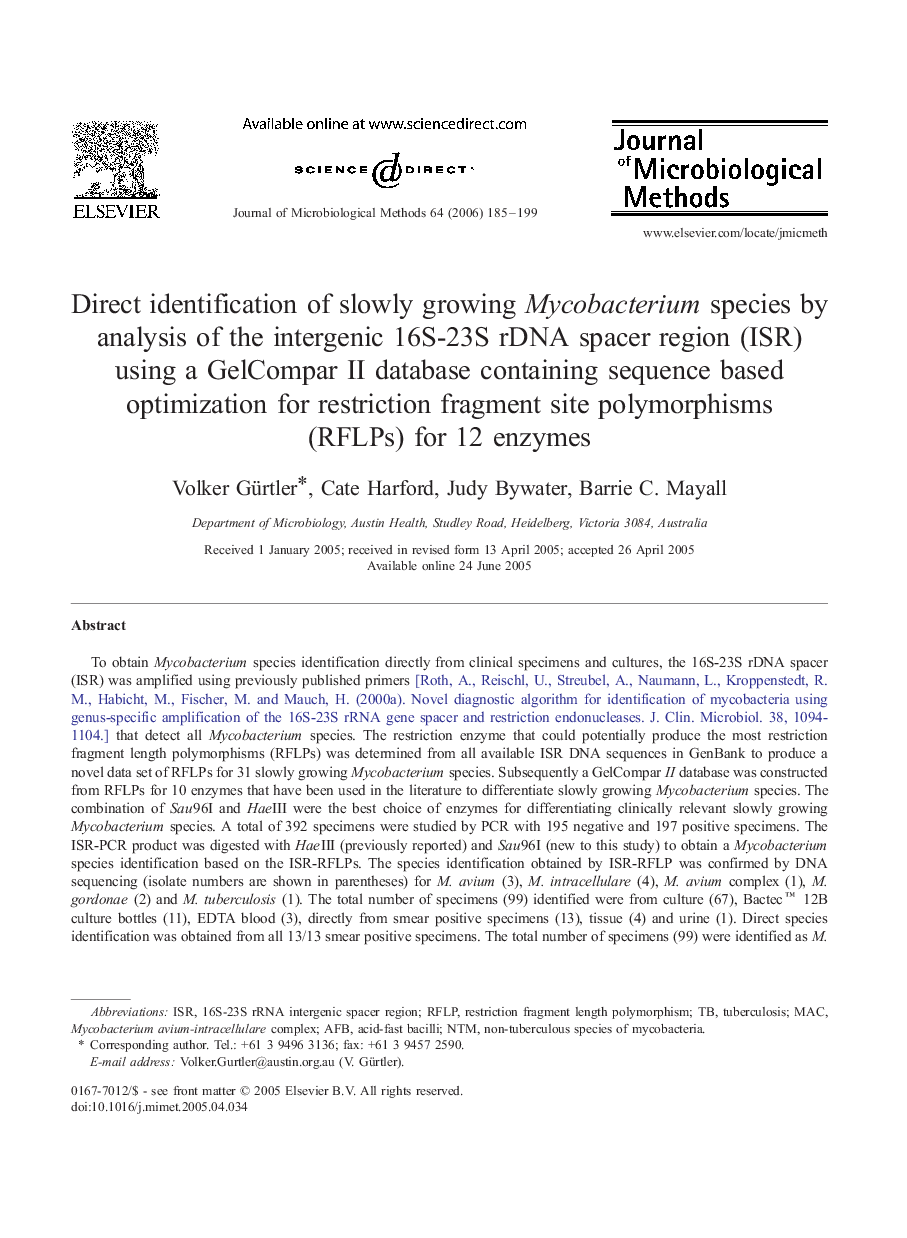| کد مقاله | کد نشریه | سال انتشار | مقاله انگلیسی | نسخه تمام متن |
|---|---|---|---|---|
| 2091424 | 1081545 | 2006 | 15 صفحه PDF | دانلود رایگان |
عنوان انگلیسی مقاله ISI
Direct identification of slowly growing Mycobacterium species by analysis of the intergenic 16S-23S rDNA spacer region (ISR) using a GelCompar II database containing sequence based optimization for restriction fragment site polymorphisms (RFLPs) for 12 en
دانلود مقاله + سفارش ترجمه
دانلود مقاله ISI انگلیسی
رایگان برای ایرانیان
کلمات کلیدی
موضوعات مرتبط
علوم زیستی و بیوفناوری
بیوشیمی، ژنتیک و زیست شناسی مولکولی
بیوتکنولوژی یا زیستفناوری
پیش نمایش صفحه اول مقاله

چکیده انگلیسی
To obtain Mycobacterium species identification directly from clinical specimens and cultures, the 16S-23S rDNA spacer (ISR) was amplified using previously published primers [Roth, A., Reischl, U., Streubel, A., Naumann, L., Kroppenstedt, R. M., Habicht, M., Fischer, M. and Mauch, H. (2000a). Novel diagnostic algorithm for identification of mycobacteria using genus-specific amplification of the 16S-23S rRNA gene spacer and restriction endonucleases. J. Clin. Microbiol. 38, 1094-1104.] that detect all Mycobacterium species. The restriction enzyme that could potentially produce the most restriction fragment length polymorphisms (RFLPs) was determined from all available ISR DNA sequences in GenBank to produce a novel data set of RFLPs for 31 slowly growing Mycobacterium species. Subsequently a GelCompar II database was constructed from RFLPs for 10 enzymes that have been used in the literature to differentiate slowly growing Mycobacterium species. The combination of Sau96I and HaeIII were the best choice of enzymes for differentiating clinically relevant slowly growing Mycobacterium species. A total of 392 specimens were studied by PCR with 195 negative and 197 positive specimens. The ISR-PCR product was digested with HaeIII (previously reported) and Sau96I (new to this study) to obtain a Mycobacterium species identification based on the ISR-RFLPs. The species identification obtained by ISR-RFLP was confirmed by DNA sequencing (isolate numbers are shown in parentheses) for M. avium (3), M. intracellulare (4), M. avium complex (1), M. gordonae (2) and M. tuberculosis (1). The total number of specimens (99) identified were from culture (67), Bactec⢠12B culture bottles (11), EDTA blood (3), directly from smear positive specimens (13), tissue (4) and urine (1). Direct species identification was obtained from all 13/13 smear positive specimens. The total number of specimens (99) were identified as M. tuberculosis (41), M. avium (7), M. avium complex (11), M. intracellulare MIN-A (20), M. flavescens (2), M. fortuitum (10), M. gordonae (4), M. shimoidei (1), M. ulcerans (1) and M. chelonae (2). This method reduces the time taken for Mycobacterium species identification from 8-10 weeks for culture and biochemical identification; to 4-6 weeks for culture and ISR-RFLP; to 2 days for smear-positive specimens by ISR-RFLP. The precise 2 day identification obtained may provide significant advantages in clinical management.
ناشر
Database: Elsevier - ScienceDirect (ساینس دایرکت)
Journal: Journal of Microbiological Methods - Volume 64, Issue 2, February 2006, Pages 185-199
Journal: Journal of Microbiological Methods - Volume 64, Issue 2, February 2006, Pages 185-199
نویسندگان
Volker Gürtler, Cate Harford, Judy Bywater, Barrie C. Mayall,